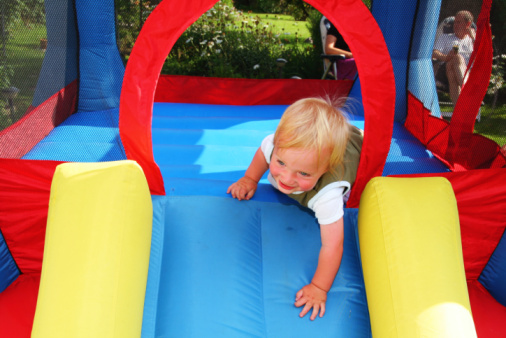Oklahoma Children at Risk of Injury in Bounce Houses

Inflatable bounce houses are a big hit as schools, carnivals and parents use them to entertain children on special occasions. But a day of bouncing around with friends can turn dangerous and lead to serious injuries.
Recently, high winds sent a bounce house with children playing inside rolling into a Colorado field, some 300 feet from where it was set up, Today.com reported.With wind gusts hitting 30 mph, a young girl was ejected from the bounce house when it came untethered, and a 10-year-old boy inside was taken to the hospital after suffering an injury.
Air Bound, the company running the bounce house that day, called it a freak accident and said the inflatable house was secured correctly and monitored.
But experts say children shouldn’t be allowed to play in inflatable bounce houses when the wind is howling.
In fact, just two weeks before the Colorado incident, high winds in South Glens Falls, N.Y., blew away an inflatable bounce house and seriously injured two boys, ages 5 and 6, Today.com reported. A similar incident in 2011 injured 13 people in Long Island, N.Y., when the wind pulled a bounce house loose from the ground.
Troubling Statistics
Dr. Gary Smith of Nationwide Children’s Hospital in Columbus, Ohio, began seeing so many pediatric injuries stemming from bounce house accidents that he conducted a study to determine their prevalence, according to CNN.com.
Smith led a search of the National Electronic Injury Surveillance System, which tallies information from injuries connected to consumer products, and found that bounce-house injuries increased 1,500 percent from 1995 to 2010. The rate doubled from 2008 to 2010 alone.
An average of 31 children underwent emergency room treatment for these injuries each day in the final year of the study, about one child every 45 minutes, according to Smith’s study.
Fifty-five percent of the 65,000 children’s injuries took place between 2005 and 2010, with more than half of the injured children ages 6 to 12 and a third under age 5.
Most injuries affected arms and legs, but younger children, those under 5, showed a higher rateof fractures. Teens primarily suffered sprains and strains.
One of five children injured sustained head and neck injuries, but only 3 percent had to be hospitalized, Smith’s study found.
Policing Inflatables
Oklahoma Statutes regulate the safety of amusement rides and they apply to the inflatable industry:
- Amusement ride owners must keep updated maintenance, inspection and repair records.
- Signs must be displayed for riders’ safety responsibilities.
- Anyone operating an amusement ride must apply for a certificate of inspection.
- Operators must have a $1 million insurance policy.
- Air-supported structures must meet certain specifications, and no toy-grade inflatables are allowed for rent.
- All inflatable devices must meet rules for anchoring and tie-downs, blowers, structures and operations.
- Rental companies must have training programs for renters and proof of insurance for all rental inflatable amusement devices.
If you take your children to an eventwhere inflatables are present, make sure the operator is following these guidelines. If the wind is blowing, don’t let your children participate. Also, avoid situations where too many children are bouncing at once.
If your child sustains an injury because of negligence on the part of the operator or renter, contact an attorney experienced in product-liability and personal injury cases. You might have the right to compensation for injuries.
Blog CATEGORIES
Let's Talk About It
Speak with an experienced attorney at no cost to you

